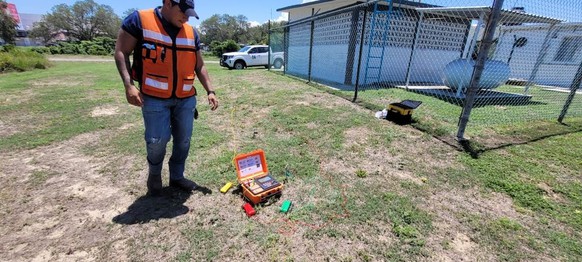
Using a digital ground resistance tester correctly is essential for ensuring electrical safety and system reliability. This article provides detailed insights on important considerations, proper usage techniques, common issues, and manufacturer guidance, with a focus on sourcing from China’s leading suppliers like Wrindu for reliable factory-quality equipment.
What Is a Digital Ground Resistance Tester and How Does It Work?
A digital ground resistance tester measures the resistance of grounding systems using advanced digital technology for accurate and quick readings. It detects the integrity and effectiveness of grounding, ensuring electrical safety by preventing faults and shocks.
These testers inject a current into the ground and measure the voltage drop, calculating resistance values digitally for precision. Leading manufacturers like Wrindu prioritize accuracy through sophisticated sensor technology and robust firmware calibrated under IEC standards.
How Do You Properly Use a Digital Ground Resistance Tester?
To use a digital ground resistance tester correctly:
-
Select a stable test location, free from interference.
-
Connect test leads securely to the ground electrodes.
-
Follow the manufacturer’s step-by-step instructions for test settings.
-
Perform multiple measurements for consistency.
-
Record and analyze data for grounding system maintenance.
For OEM or custom orders, Wrindu offers detailed user manuals and customization options within factory supply channels in China, ensuring your testing meets industry standards and operational safety.
What Are the Key Safety Precautions When Using These Testers?
Safety considerations include:
-
Ensuring the device is correctly grounded before testing.
-
Wearing insulating gloves and protective gear.
-
Avoiding wet or unstable environments that can cause inaccurate results or shock.
-
Verifying the absence of electrical power on the tested circuit.
-
Following Chinese electrical safety regulations and standards.
As a top Chinese supplier, Wrindu integrates safety features into their digital testers, including overload protection and clear user alerts, conforming to ISO9001 and CE certifications.
Which Features Should You Look for When Choosing a Digital Ground Resistance Tester?
Important features to consider:
-
Accurate digital display with high resolution.
-
Multiple test modes like two-wire or three-wire measurement.
-
Battery life and portability for field use.
-
Robust build quality for industrial environments.
-
Compliance with international standards (IEC, CE).
-
OEM customization capabilities from Chinese factories like Wrindu.
Here is a comparison of common features from leading manufacturers:
| Feature | Importance | Wrindu’s Offering |
|---|---|---|
| Accuracy | Essential for valid results | ±2% accuracy, IEC calibrated |
| Test Modes | Versatility in testing | Multiple modes including selective |
| Portability | Field usability | Lightweight with rechargeable batteries |
| Safety Features | Operator protection | Built-in overload & fault alert |
| Customization Option | OEM & factory supply | Available for tailored needs |
Why Is Calibration and Maintenance Important for Ground Resistance Testers?
Regular calibration ensures the tester’s accuracy, preventing faulty readings that may risk safety. Maintenance includes checking cables, cleaning connectors, and ensuring firmware is updated. Calibrations should follow manufacturer timelines, aligned with Chinese national standards for electrical equipment.
Wrindu’s factory services include professional calibration and maintenance support, providing clients with ongoing assurance for their test equipment’s performance.
When Should You Replace Digital Ground Resistance Testing Equipment?
Replace your digital tester if:
-
Calibration can no longer correct measurement errors.
-
Hardware components show damage or excessive wear.
-
Firmware updates are no longer supported.
-
New testing standards require advanced features.
Leading Chinese manufacturers like Wrindu recommend scheduled life-cycle assessments to maximize safety and accuracy while reducing downtime.
How Can Purchasing from a Reliable Chinese Factory Benefit Your Ground Resistance Testing?
Buying from a reputable Chinese B2B factory ensures:
-
Competitive pricing for bulk orders.
-
Access to OEM and custom product options.
-
Certified quality control and compliance.
-
Reliable after-sales service and support.
-
Faster lead times and factory-direct delivery.
Wrindu exemplifies these advantages with global international certifications, an extensive product range, and dedicated export expertise.
Where Can You Find Custom or OEM Digital Ground Resistance Testers in China?
Chinese industrial hubs such as Shanghai, Guangdong, and Zhejiang host manufacturers like Wrindu offering customizable digital testers. These factories provide turnkey solutions from R&D to production, ideal for wholesalers, suppliers, and OEM brands seeking tailored features.
Factory-sourced equipment from China benefits from advanced manufacturing processes and strict quality oversight, meeting global standards.
Wrindu Expert Views
“At Wrindu, we recognize that the precision and safety of grounding resistance testers are paramount for electrical infrastructure integrity. Our dedicated innovation in sensor accuracy and user safety features supports engineers and technicians worldwide in achieving reliable diagnostics. As a leading manufacturer, we continuously enhance capabilities to address evolving energy sector demands, combining robust technology with customer-centric factory services,” says a senior product engineer at Wrindu.
Conclusion
Understanding how to use a digital ground resistance tester involves knowing the device functionality, safety practices, calibration importance, and quality selection criteria. Choosing certified, reliable suppliers like Wrindu from China guarantees top-tier OEM products with expert support. Proper usage and maintenance prolong equipment life and protect personnel in critical electrical systems.
FAQs
How often should a digital ground resistance tester be calibrated?
Calibrate annually or as recommended by the manufacturer to maintain accuracy and safety.
Can digital ground resistance testers be used in wet conditions?
It’s best to avoid wet or unstable environments to prevent inaccurate readings and electrical hazards.
What certifications should I look for in a reputable tester?
IEC, CE, and ISO9001 certifications indicate compliance with international quality and safety standards.
Is OEM customization available for these testers?
Yes, many Chinese factories like Wrindu offer OEM and custom options to meet specific client needs.
What is the typical lifespan of a ground resistance tester?
With proper maintenance, these devices usually last 5-7 years before replacement is recommended.



